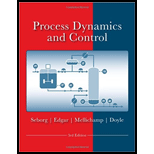
(a)
Interpretation:
The transfer function
Concept introduction:
For chemical processes, dynamic models consisting of ordinary differential equations are derived through unsteady-state conservation laws. These laws generally include mass and energy balances.
The process models generally include algebraic relationships which commence from
The difference in the actual variable
In the steady-state process, the accumulation in the process is taken as zero.
(b)
Interpretation:
The transient response of
Concept introduction:
For chemical processes, dynamic models consisting of ordinary differential equations are derived through unsteady-state conservation laws. These laws generally include mass and energy balances.
The process models generally include algebraic relationships which commence from thermodynamics, transport phenomena, chemical kinetics, and physical properties of the processes.
(c)
Interpretation:
The new steady-state levels for both the systems are to be determined.
Concept introduction:
For chemical processes, dynamic models consisting of ordinary differential equations are derived through unsteady-state conservation laws. These laws generally include mass and energy balances.
The process models generally include algebraic relationships which commence from thermodynamics, transport phenomena, chemical kinetics, and physical properties of the processes.
For a large value of time, the asymptotic value of
This theorem is applicable only if
(d)
Interpretation:
The tank that will overflow first and the time of overflow is to be determined.
Concept introduction:
For chemical processes, dynamic models consisting of ordinary differential equations are derived through unsteady-state conservation laws. These laws generally include mass and energy balances.
The process models generally include algebraic relationships which commence from thermodynamics, transport phenomena, chemical kinetics, and physical properties of the processes.
(e)
Interpretation:
The new steady-state levels for both the systems are to be determined.
Concept introduction:
For chemical processes, dynamic models consisting of ordinary differential equations are derived through unsteady-state conservation laws. These laws generally include mass and energy balances.
The process models generally include algebraic relationships which commence from thermodynamics, transport phenomena, chemical kinetics, and physical properties of the processes.
Want to see the full answer?
Check out a sample textbook solution
Chapter 5 Solutions
Process Dynamics and Control, 4e
 Introduction to Chemical Engineering Thermodynami...Chemical EngineeringISBN:9781259696527Author:J.M. Smith Termodinamica en ingenieria quimica, Hendrick C Van Ness, Michael Abbott, Mark SwihartPublisher:McGraw-Hill Education
Introduction to Chemical Engineering Thermodynami...Chemical EngineeringISBN:9781259696527Author:J.M. Smith Termodinamica en ingenieria quimica, Hendrick C Van Ness, Michael Abbott, Mark SwihartPublisher:McGraw-Hill Education Elementary Principles of Chemical Processes, Bind...Chemical EngineeringISBN:9781118431221Author:Richard M. Felder, Ronald W. Rousseau, Lisa G. BullardPublisher:WILEY
Elementary Principles of Chemical Processes, Bind...Chemical EngineeringISBN:9781118431221Author:Richard M. Felder, Ronald W. Rousseau, Lisa G. BullardPublisher:WILEY Elements of Chemical Reaction Engineering (5th Ed...Chemical EngineeringISBN:9780133887518Author:H. Scott FoglerPublisher:Prentice Hall
Elements of Chemical Reaction Engineering (5th Ed...Chemical EngineeringISBN:9780133887518Author:H. Scott FoglerPublisher:Prentice Hall
 Industrial Plastics: Theory and ApplicationsChemical EngineeringISBN:9781285061238Author:Lokensgard, ErikPublisher:Delmar Cengage Learning
Industrial Plastics: Theory and ApplicationsChemical EngineeringISBN:9781285061238Author:Lokensgard, ErikPublisher:Delmar Cengage Learning Unit Operations of Chemical EngineeringChemical EngineeringISBN:9780072848236Author:Warren McCabe, Julian C. Smith, Peter HarriottPublisher:McGraw-Hill Companies, The
Unit Operations of Chemical EngineeringChemical EngineeringISBN:9780072848236Author:Warren McCabe, Julian C. Smith, Peter HarriottPublisher:McGraw-Hill Companies, The





